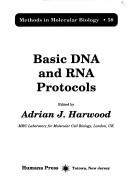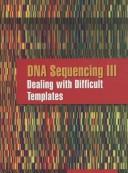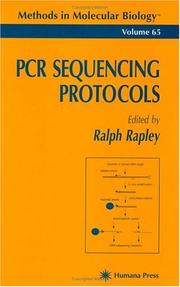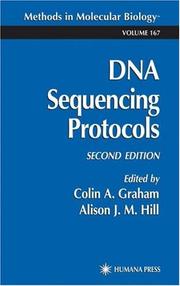| Listing 1 - 10 of 17 | << page >> |
Sort by
|
Book
Year: 1992 Publisher: Washington, D.C. : Oak Ridge, TN : U.S. Dept. of Energy, Office of Energy Research, Office of Health and Environmental Research ; Human Genome Management Information System, Oak Ridge National Laboratory,
Abstract | Keywords | Export | Availability | Bookmark
 Loading...
Loading...Choose an application
- Reference Manager
- EndNote
- RefWorks (Direct export to RefWorks)
An introduction to basic principles of molecular genetics pertaining to the Genome Project.
Human gene mapping. --- Human molecular genetics. --- Chromosome Mapping. --- Genome, Human. --- Sequence Analysis, DNA.

ISBN: 0896035735 9786610832873 1280832878 159259686X Year: 2000 Volume: 130 Publisher: Totowa, NJ : Humana Press : Imprint: Humana,
Abstract | Keywords | Export | Availability | Bookmark
 Loading...
Loading...Choose an application
- Reference Manager
- EndNote
- RefWorks (Direct export to RefWorks)
In Transcription Factor Protocols, Martin Tymms has created a powerful compendium of the major techniques for the study of those DNA sequences and protein factors that regulate the transcription of protein encoding genes. With chapters contributed by leading investigators well versed in the methods, this eminently practical compendium includes not only well established protocols, but also novel techniques that are now being widely adopted. Among the important new methods treated are the use of triplex-forming oligonucleotides, the application of whole genome PCR to the isolation of gene promoters/enhancers, the analysis of in vivo methylation, and in vivo footprinting using UV light and ligation-mediated PCR. Step-by-step instructions, tips about pitfalls to avoid, and extensive procedural notes all help to ensure robust and reproducible results.Transcription Factor Protocols offers both experienced workers and new researchers a vital first-stop reference collection of the core techniques for all those exploring the role of transcription factors in gene regulation today.
Transcription Factors --- Sequence Analysis, DNA --- Transfection --- Transcription factors --- Facteurs de transcription --- analysis --- methods --- Laboratory manuals --- Manuels de laboratoire --- Laboratory manuals. --- analysis. --- methods. --- Sequence analysis, dna --- Methods. --- Analysis. --- Proteins. --- Proteids --- Biomolecules --- Polypeptides --- Proteomics --- Genetic transcription factors --- Proteins --- Human genetics. --- Human Genetics. --- Genetics --- Heredity, Human --- Human biology --- Physical anthropology

ISBN: 0896032485 1592595103 1489939962 Year: 1993 Volume: 23 Publisher: Totowa, NJ : Humana Press : Imprint: Humana,
Abstract | Keywords | Export | Availability | Bookmark
 Loading...
Loading...Choose an application
- Reference Manager
- EndNote
- RefWorks (Direct export to RefWorks)
The purpose of DNA Sequencing Protocols is to provide detailed practical procedures for the widest range of DNA sequencing meth ods, and we believe that all the vanguard techniques now being applied in this fast-evolving field are comprehensively covered. Sequencing technology has advanced at a phenomenal rate since the original methods were first described in the late 1970s and there is now a huge variety of strategies and methods that can be employed to determine the sequence of any DNA of interest. More recently, a large number of new and innovative sequencing techniques have been developed, including the use of such novel polymerases as Tag poly merase and Sequenase, the harnessing of PCR technology for linear amplification (cycle) sequencing, and the advent of automated DNA sequencers. DNA sequencing is surely one of the most important techniques in the molecular biology laboratory. Sequence analysis is providing an increasingly useful approach to the characterization of biological systems, and major multinational projects are already underway to map and sequence the entire genome of organisms, such as Escherichia coli, Saccharomyces cerevisiae, Caenorhabditis elegans, and Homo sapiens. Most scientists recognize the importance of DNA sequence data and perceive DNA sequencing as a valuable and indispensable aspect of their work. Recent technological advances, especially in the area of automated sequencing, have removed much of the drudg ery that was formerly associated with the technique, whereas innova tive computer software has greatly simplified the analysis and manipulation of sequence data.
Sequence Analysis, DNA --- Nucleotide sequence --- Séquence nucléotidique --- Nucleotide sequence. --- Sequence Analysis --- Genetic Techniques --- Investigative Techniques --- Analytical, Diagnostic and Therapeutic Techniques and Equipment --- Animal Biochemistry --- Human Anatomy & Physiology --- Health & Biological Sciences --- Sequence Analysis, DNA. --- 57.088.5 --- 577.212.3 --- Methods and techniques for studying structures and properties of biological molecules --- Nucleic acid base and sequence compositon. Experimental deciphering of genetic code. --- 577.212.3 Nucleic acid base and sequence compositon. Experimental deciphering of genetic code. --- Sequence analysis, dna. --- Séquence nucléotidique --- Analysis, Nucleic acid sequence --- Analysis, Nucleotide sequence --- Base sequence (Nucleic acids) --- DNA sequence --- Nucleic acid sequence analysis --- Nucleotide sequence analysis --- RNA sequence --- Sequence, Nucleotide --- Nucleic acids --- Nucleotides --- Sequence alignment (Bioinformatics) --- Nucleic acid base and sequence compositon. Experimental deciphering of genetic code --- Analysis --- Life sciences. --- Cell biology. --- Life Sciences. --- Cell Biology. --- Cell biology --- Cellular biology --- Biology --- Cells --- Cytologists --- Biosciences --- Sciences, Life --- Science --- Cytology.
Periodical
ISSN: 13402838 17561663 Year: 1994 Publisher: Tokyo, Japan : Oxford ; Cary, NC : Kazusa DNA Research Institute : Universal Academy Press Oxford University Press
Abstract | Keywords | Export | Availability | Bookmark
 Loading...
Loading...Choose an application
- Reference Manager
- EndNote
- RefWorks (Direct export to RefWorks)
Genes --- Genome --- Sequence Analysis, DNA --- Genomes --- Genomics --- DNA --- Gènes --- Génomes --- Génomique --- ADN --- Periodicals --- Research --- Périodiques --- Recherche --- Genes. --- Genome. --- Sequence Analysis, DNA. --- Chemistry --- Engineering --- Health Sciences --- Life Sciences --- Biochemistry --- Biotechnology --- Genetics --- Immunology --- Biology --- General and Others --- genomic structure --- genomic function --- genomes --- gene analysis --- bioinformatic analysis --- genomic data --- Genomes. --- Genomics. --- Research. --- Deoxyribonucleic acid --- Desoxyribonucleic acid --- Thymonucleic acid --- TNA (Nucleic acid) --- Deoxyribose --- Nucleic acids --- Units of heredity --- Units of inheritance --- Heredity --- Molecular genetics --- Proteome --- Analysis, DNA Sequence --- DNA Sequence Determination --- DNA Sequence Determinations --- DNA Sequencing --- Determination, DNA Sequence --- Determinations, DNA Sequence --- Sequence Determinations, DNA --- DNA Sequence Analysis --- Sequence Determination, DNA --- Analyses, DNA Sequence --- DNA Sequence Analyses --- Sequence Analyses, DNA --- Sequencing, DNA --- Molecular Sequence Annotation --- Cistron --- Gene --- Genetic Materials --- Cistrons --- Genetic Material --- Material, Genetic --- Materials, Genetic --- Genome research --- Haploidy --- Sequence Analysis, DNA/ --- Gènes. --- Génomes. --- Gènes. --- Génomes. --- Génomique --- Gènes --- Génomes

ISBN: 0896033317 089603402X 1280835974 1592592511 9780896033313 Year: 1996 Volume: 58 Publisher: Totowa, NJ : Humana Press : Imprint: Humana,
Abstract | Keywords | Export | Availability | Bookmark
 Loading...
Loading...Choose an application
- Reference Manager
- EndNote
- RefWorks (Direct export to RefWorks)
An essential core collection of the latest molecular and genetic techniques for cloning, subcloning, sequencing, PCR, protein expression, and much more. Each protocol represents a time-tested, step-by-step recipe that creates an understanding of the procedure, easily reproducible results, and confidence that the procedure will work. The collection includes not only many updated and improved classic techniques, but also a powerful group of advanced methods that point to future progress, among them nonisotopic DNA labeling, silver staining, and automatic sequencing. This excellent bench companion will help those who need to learn for the first time how to conduct research on the molecular biology of nucleic acids or those who need to broaden their competence and laboratory skills. Even highly skilled researchers will find many time-saving techniques.
General biochemistry --- Molecular biology --- Nucleic acids --- Laboratory manuals. --- Nucleic Acids --- Sequence Analysis, DNA. --- Polymerase Chain Reaction --- Investigative Techniques --- Genetic Techniques --- Analytical, Diagnostic and Therapeutic Techniques and Equipment --- Human Anatomy & Physiology --- Animal Biochemistry --- Health & Biological Sciences --- methods. --- Laboratory manuals --- Life sciences. --- Cell biology. --- Life Sciences. --- Cell Biology. --- Cell biology --- Cellular biology --- Biology --- Cells --- Cytologists --- Biosciences --- Sciences, Life --- Science --- Cytology. --- Nucleic acids - Laboratory manuals.
Book
ISSN: 18612253 ISBN: 9783540749660 9783540749653 3540749659 3642094376 9786611138790 1281138797 3540749667 Year: 2008 Publisher: Berlin, Heidelberg : Springer Berlin Heidelberg : Imprint: Springer,
Abstract | Keywords | Export | Availability | Bookmark
 Loading...
Loading...Choose an application
- Reference Manager
- EndNote
- RefWorks (Direct export to RefWorks)
Retroelements are ancient mobile DNA found in most organisms. Long dismissed as useless, selfish or "junk" DNA, they were thought to be mere intracellular parasites from our distant evolutionary past. Together with their mutant relatives, L1 sequences constitute almost 50% of the mammalian genome. L1s can retrotranspose in a defined window of the neuronal differentiation, changing the genetic information in single neurons in a "random" fashion, allowing the brain to develop in distinct different ways. Such strategy contributes to expand the number of functionally distinct neurons that could be produced from a given stem cell gene pool. This characteristic of variety and flexibility may contribute to the uniqueness of an individual brain, even between genetically identical twins. These mobile elements may be part of conserved core process responsible for evoking facilitated complex non-random phenotypical variation on which selection may act. A detailed understanding of the basic mechanisms of L1 activity may shed light on one possible mechanism for generating neural diversity. The book results from a fascinating and stimulating exchange of ideas at the interface of the complexity of brain organization and function, the mechanisms for generating diversity and genetic mobility. This meeting of leading geneticists, molecular biologists and neuroscientists was organized by the Fondation IPSEN. Its ambitious goal was to expand the current limits of research in neurobiology not only to the benefit of those interested in the cellular and molecular processes but also for the understanding of high-level cognitive functions and the understanding of complex mental diseases. The reader can judge how far the book achieves this.
genetica --- Neuropathology --- Human genetics --- neurologie --- medische genetica --- Retroelements --- Sequence Analysis, DNA. --- Biodiversity. --- Brain --- Genetic Variation. --- Neurogenetics. --- Neurogénétique --- genetics. --- physiology. --- Medicine. --- Human genetics. --- Neurosciences. --- Neurology. --- Medicine & Public Health. --- Human Genetics. --- Nervous system --- Genetics --- Neurosciences --- Genetic aspects --- Heredity, Human --- Human biology --- Physical anthropology --- Neural sciences --- Neurological sciences --- Neuroscience --- Medical sciences --- Medicine --- Neuropsychiatry --- Diseases --- Neurology .

ISBN: 9780763742973 076374297X Year: 2009 Publisher: Sudbury, Mass. : Jones and Bartlett Publishers,
Abstract | Keywords | Export | Availability | Bookmark
 Loading...
Loading...Choose an application
- Reference Manager
- EndNote
- RefWorks (Direct export to RefWorks)
DNA --- Nucleotide sequence --- Sequence Analysis, DNA --- Base Sequence. --- Templates, Genetic. --- Analysis. --- Methodology. --- methods. --- Analysis, Nucleic acid sequence --- Analysis, Nucleotide sequence --- Base sequence (Nucleic acids) --- DNA sequence --- Nucleic acid sequence analysis --- Nucleotide sequence analysis --- RNA sequence --- Sequence, Nucleotide --- Nucleic acids --- Nucleotides --- Sequence alignment (Bioinformatics) --- Analysis --- Methodology --- methods

ISBN: 0896033449 9786610836727 1280836725 1592595510 1489940383 Year: 1996 Volume: 65 Publisher: Totowa, NJ : Humana Press : Imprint: Humana,
Abstract | Keywords | Export | Availability | Bookmark
 Loading...
Loading...Choose an application
- Reference Manager
- EndNote
- RefWorks (Direct export to RefWorks)
Advances in bioscience research usually arise as a result of the continu ing refinement of existing technologies. However, there are a number of occa sions v^rhere newly developed methodologies have a profound effect on nearly all areas of research. Frequently these are techniques that are elegantly simple in concept and require minimal technical manipulation. Two of these revolu tionary techniques are the focus ofPCR Sequencing Protocols. The first such technique is enzymatic chain termination sequencing developed by Sanger and his co-workers in Cambridge and reported in 1977. This essentially brought the possibility of deriving nucleotide sequence information in a very short time scale and has been widely accepted in many laboratories as a routine molecular biological research tool. Furthermore, it has not only led to the sequencing of many genes and gene fragments, but has also allowed the tech nical means of sequencing the human genome. The second technique that has found widespread acceptance in basic applied research and many routine applications is the polymerase chain reac tion. This technique, first reported in 1985 by MuUis and his colleagues, pro vides the means to amplify nucleic acid sequence, which immediately proved invaluable in nearly all fields of biological laboratory research. Here, as with enzymatic DNA sequencing, is a very simple concept that relies on minimal information to prepare short oligonucleotide primers that direct the synthesis of a specified fi-agment o f DNA in the presence of a thermostable DNA polymerase.
Molecular biology --- Analytical biochemistry --- Polymerase Chain Reaction --- Sequence Analysis, DNA --- Polymerase chain reaction --- Réaction en chaîne de la polymérase --- methods --- laboratory manuals --- Laboratory manuals --- Manuels de laboratoire --- Nucleic Acid Amplification Techniques --- Genetic Techniques --- Investigative Techniques --- Analytical, Diagnostic and Therapeutic Techniques and Equipment --- Animal Biochemistry --- Human Anatomy & Physiology --- Health & Biological Sciences --- Laboratory manuals. --- Réaction en chaîne de la polymérase --- Polymerization --- Polymerisation --- Polymers --- Polymers and polymerization --- Synthesis of polymers --- Chemical reactions --- Synthesis --- laboratory manuals. --- Cytology. --- Cell Biology. --- Cell biology --- Cellular biology --- Biology --- Cells --- Cytologists --- Cell biology.

ISBN: 0896037169 0896037215 9786610820887 1280820888 1592591132 Year: 2001 Volume: 167 Publisher: Totowa, NJ : Humana Press : Imprint: Humana,
Abstract | Keywords | Export | Availability | Bookmark
 Loading...
Loading...Choose an application
- Reference Manager
- EndNote
- RefWorks (Direct export to RefWorks)
Since the publication of the first edition of DNA Sequencing Protocols in 1993, major advances in its technology have made PCR-based semiautomated fluorescent sequencing the norm and enabled the complete sequencing of complex genomes. In DNA Sequencing Protocols, 2nd Edn., Colin Graham and a team of leading investigators and expert clinical scientists update the first edition with a collection of powerful, up-to-date PCR-based methods for DNA sequencing, many suitable for human genome sequencing and mutation detection in human disease. Each method provides detailed, step-by-step instructions to ensure successful results, and includes helpful notes identifying and addressing potential problems. This second edition offers new material on automated DNA sequencers, capillary DNA sequencers, heterozygote mutation detection, web-based sequencing databases and genome sequencing sites, and the human genome project. State-of-the-art and highly practical, DNA Sequencing Protocols, 2nd Edn. constitutes an essential laboratory handbook for geneticists and molecular biologists, offering concise, easy-to-follow methods that will impact today's genome sequencing projects, improve the accuracy and quality of DNA sequences obtained by smaller laboratories, and help lay the foundation for molecular diagnostics.
Nucleotide sequence --- Génome humain --- Laboratory manuals --- Séquençage --- Manuels de laboratoire --- DNA. --- Electronic books. -- local. --- Nucleotide sequence -- Laboratory manuals. --- Sequence Analysis --- Genetic Techniques --- Investigative Techniques --- Analytical, Diagnostic and Therapeutic Techniques and Equipment --- Sequence Analysis, DNA --- Human Anatomy & Physiology --- Health & Biological Sciences --- Animal Biochemistry --- Génome humain --- Séquençage --- Deoxyribonucleic acid --- Desoxyribonucleic acid --- Thymonucleic acid --- TNA (Nucleic acid) --- Deoxyribose --- Nucleic acids --- Genes --- Analysis, Nucleic acid sequence --- Analysis, Nucleotide sequence --- Base sequence (Nucleic acids) --- DNA sequence --- Nucleic acid sequence analysis --- Nucleotide sequence analysis --- RNA sequence --- Sequence, Nucleotide --- Nucleotides --- Sequence alignment (Bioinformatics) --- Analysis --- Cytology. --- Cell Biology. --- Cell biology --- Cellular biology --- Biology --- Cells
Periodical
Abstract | Keywords | Export | Availability | Bookmark
 Loading...
Loading...Choose an application
- Reference Manager
- EndNote
- RefWorks (Direct export to RefWorks)
DNA --- Molecular genetics --- Mobile genetic elements --- ADN --- Génétique moléculaire --- Eléments génétiques mobiles --- Periodicals --- Périodiques --- Genomics --- Genomics. --- Sequence Analysis, DNA. --- Mobile genetic elements. --- Genetic elements, Mobile --- Genetic mobile elements --- Mobile DNA --- Mobile DNA sequences --- Mobile elements, Genetic --- Genome research --- Genomes --- Analysis, DNA Sequence --- DNA Sequence Determination --- DNA Sequence Determinations --- DNA Sequencing --- Determination, DNA Sequence --- Determinations, DNA Sequence --- Sequence Determinations, DNA --- DNA Sequence Analysis --- Sequence Determination, DNA --- Analyses, DNA Sequence --- DNA Sequence Analyses --- Sequence Analyses, DNA --- Sequencing, DNA --- Research --- DNA rearrangements --- DNA recombination --- Molecular Sequence Annotation --- Human Genome Project --- Genome --- DNA. --- Comparative Genomics --- Comparative Genomic --- Genomic, Comparative --- Genomics, Comparative --- Genetics --- dna rearrangements --- dna recombination
| Listing 1 - 10 of 17 | << page >> |
Sort by
|

 Search
Search Feedback
Feedback About
About Help
Help News
News